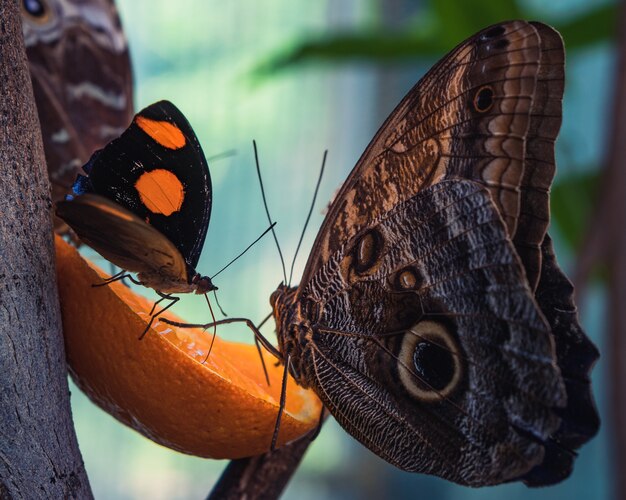

Monarch butterflies are known for their distinctive orange and black striped wings.
These butterflies are native to North and South America.
Monarch butterflies undertake an annual migration, traveling thousands of miles each year.
The migration of monarch butterflies is one of the greatest natural phenomena in the world.
Monarch butterflies are the only insect species that migrates thousands of miles annually.
The average lifespan of a monarch butterfly is only six to eight weeks.
Monarch butterflies go through four stages of development: egg, larva (caterpillar), pupa (chrysalis), and adult.
The caterpillars of monarch butterflies feed exclusively on milkweed plants.
Monarch butterflies have a complex and toxic defense mechanism called aposematism to deter predators.
These butterflies are famous for their incredible ability to navigate using the Earth’s magnetic field.
Monarch butterflies are known for their remarkable resilience and adaptability to different climates.
The largest population of monarch butterflies can be found in the Monarch Butterfly Biosphere Reserve in Mexico.
Monarch butterflies are an important species in pollination, contributing to the growth and survival of other plants.
They are a symbol of conservation and environmental awareness, representing the need to protect habitats.
Monarch butterflies are a favorite subject of photography enthusiasts due to their vibrant colors.
The famous monarch butterfly life cycle is often used as a metaphor for personal growth and transformation.
Monarch butterflies have been the focus of extensive scientific research to understand their migration patterns.
These butterflies have a special place in many cultures, symbolizing beauty, freedom, and transformation.
The mating ritual of monarch butterflies involves elaborate aerial dances.
Monarch butterflies possess a unique chemical sense that helps them find nectar sources.
Female monarch butterflies lay hundreds of eggs during their short lifespan.
Monarch butterflies play a significant role in maintaining biodiversity by spreading the pollen of various flowers.
The decline in milkweed plants, due to habitat loss and pesticide use, poses a threat to monarch butterfly populations.
Monarch butterflies are capable of flying at speeds of up to 25 miles per hour.
These butterflies hibernate in groves of trees during the winter months.
Monarch butterflies exhibit stunning migratory patterns, sometimes traveling more than 3,000 miles.
The monarch butterfly population has been declining in recent years, raising concerns about their conservation status.
To survive the long migration, monarch butterflies store fat reserves for energy.
The coloration of monarch butterflies serves as a warning to predators, indicating their toxic nature.
Monarch butterflies are frequently used in educational programs to teach students about metamorphosis and the natural world.
The unique pattern on each monarch butterfly’s wings helps scientists track their migration patterns.
Monarch butterflies have been studied by scientists to better understand how they navigate and adapt to changing environments.
Some monarch butterflies have been found to migrate across the Atlantic Ocean from North America to Europe.
Monarch butterflies have been known to travel over 100 miles a day during their migration.
The monarch butterfly is the state insect of Alabama, Idaho, Illinois, Minnesota, Texas, Vermont, and West Virginia.
Monarch butterflies are excellent long-distance fliers, often using wind currents to aid in their journey.
The iconic orange and black coloration of monarch butterflies also serves as a camouflage in their natural habitat.
Monarch butterflies are capable of crossing large bodies of water, such as the Gulf of Mexico, during their migration.
These butterflies undergo a remarkable transformation from a tiny egg to a majestic winged creature.
Monarch butterflies have been observed engaging in puddling, where they gather on moist soils to obtain nutrients.
Monarch butterflies are avid sunbathers, often basking in the warmth of the sun to increase their body temperature.
Monarch butterflies have a delicate and fragile appearance, but they are resilient creatures capable of enduring harsh conditions.
The magnificence of a monarch butterfly’s flight has inspired countless poets and artists throughout history.
Monarch butterflies are sensitive to changes in their environment, making them valuable indicators of ecological health.
The monarch butterfly is a symbol of hope and conservation, reminding us of our responsibility to protect the natural world.
Around the world, coffee enthusiasts enjoy Monin coffee concentrate since it is a multipurpose product. Conveniently combining…
The Importance of Choosing the Right Shower for Your Bathroom Renovating your bathroom can be…
Usain Bolt holds the record for the fastest 100-meter sprint in history.Bolt was named Sportsman…
Love is in the air... and it smells suspiciously like chocolate!Roses are red, violets are…
Life's a beach, take a picture and relax.Sun, sand, and salty kisses. That's what beach…
Hungary is home to the largest thermal water cave system in the world.The Rubik's Cube…